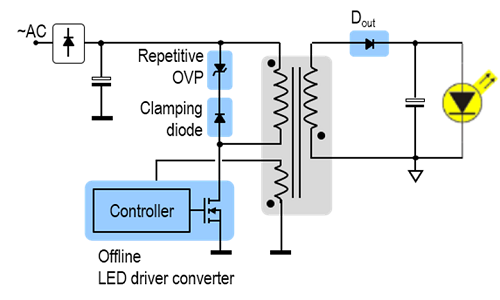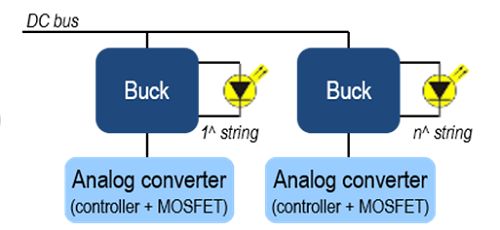
LED general lighting market continuously grow and needs new smart features, more and more high efficiency and cost saving. In this article will be showed how STMicroelectronics is able to satisfy with his wide products portfolio the market requests; three of the main applications (residential, commercial and street lighting) are focused. The ST product offer is presented starting from a system point of view: the description of main architectures, the fitting products and evaluation tools are discussed in the article.
Introduction
The analysts forecast (“The world market for power in LED Lighting”, IHS report March 2016) the LED General Lighting segment market from 2015-2020, by applications, will grow at a CAGR of 25% for Residential, of 29% for Commercial (retail and office) and of 16.9% for Street lighting. This growing is based on two main factors. The first one is due to the fact that some big countries have become more energy conscious and they have already introduced the regulations to phase out incandescent lamps in favor of more energy-efficient light sources such as LEDs. The second factor is related to the rapid urbanization taking place in emerging economies has resulted in a drastic increase in the number of households that require lighting sources and in need of improved urban infrastructure. According with this analysis, following is reported the ST’s offer for residential, commercial and street lighting LED applications.

STMICROELECTRONICS’ OFFER
STMicroelectronics is able to cover all the needs of the LED lighting General illumination applications with a wide products portfolio including dedicated and suitable products.
Depending on the applications (residential, commercial or street lighting), following are reported the main used architectures/circuits, the ST’ product offer for each of these and the main related system evaluation boards. A separate section is dedicated to eDesignSuite the ST’s software tool dedicated to power management applications included LED lighting.
Residential
LED efficacy and driver IC market requirements are constantly evolving. Residential lighting applications need a high integration level, high efficiency, high power factor (HPF), long lifetime, and dimming capabilities as well as a low system cost and component count.
ST offers a wide portfolio of highly integrated offline converters up to 15 W (each IC includes a power MOSFET combined with control and protection circuitry on a single chip) working with a high breakdown voltage of 800 V able to manage the main used topologies in the market (Buck, Buck-Boost and Flyback). Among these, HVLED805, HVLED807PF, and HVLED815PF, dedicated offline LED driver converters work with a high PF and in constant-current/constant-voltage mode primary-side regulation (PSR-CC/CV), see figure 1, avoiding the need of secondary side regulation IC and opto-coupler in the circuit, thus reducing costs. The other offline converters family suitable for LED driving is the VIPerPlus series (Viper*5, VIPer*6, VIPer*7, VIPer*8, VIPer0P and VIPer01).

Concerning the Flyback topologies, STRVS* repetitive overvoltage protections and STTH* ultrafast diodes (pn from 600V to 1200V) are suggested for the clamping circuit; the STPS* schottky diodes and FERD* field effect rectifier fit very well for the output rectification. The low leakage current of STRVS*, the low VF/IR of the output diodes and the best VF/trr tradeoff of STTH*, guarantee reliability and efficiency to the Flyback.
Thanks to its high-power-density (up to 61V/3A) LED5000, LED6000 DC-DC LED driver converters (controller + MOSFET in the same chip), ST can support MR16 LED replacement lamps for halogen light bulbs.
ST offers a wide offer of system evaluation boards for Residential, the main ones are reported in fig.2.

Commercial
Commercial and architectural lighting applications usually require more than 20 W, a high power factor, high level of efficiency, cost-saving solution and the possibility of using more than one LED string (single or multiple strings) with remote monitoring.
In a single string case, the flyback topology is used mainly. Working in constant-current primary-side regulation (PSR-CC) mode, ST’s new HVLED003D (available in Q4 2016) flyback offline LED driver controller with embedded dimming capability (0-10, PWM and Triac), directly drives the single string without having to use an optocoupler and secondary-side controller in the circuit.
For the main related switch, the MDmesh™ K5 power MOSFETs series is suggested, in particular the 800-900-950Vbr part numbers (ST*N80K5, ST*N90K5 and ST*N95K5 pn) fit very well. The MDmesh™ K5 series suits for the hard switching topologies, and it has a very low Rdson, and small Qg and capacitance.
For the clamping net, are suggested the same devices reported in the Residential main. For the output rectification, the STPS* schottky diodes, the FERD* field effect rectifier and the Ultrafast diodes series (STTH* with ≥200V) can be used.
The multiple strings power supply architecture consists of a main power supply (usually a flyback) providing a constant DC bus voltage and subsequent multiple strings (fig.3).

ST’s offline LED controller HVLED001/A with constant-voltage primary-side regulation (PSR-CV) with diiming capability (0-10, PWM) is available for the flyback. PSR-CV means doesn’t need to use an optocoupler and secondary-side controller in the circuit. Power MOSFETs, output diodes and clamping net used for this flyback are the same of the ones described in the single string approach.
The subsequent multiple strings can be managed using analog or digital means:
High power-density (up to 61V/3A) DC-DC LED driver Buck converters (controller + MOSFET in the same chip) LED2000, LED2001, LED5000 and LED6000 (fig.4) are available for an analog implementation.
The new HVLED0002 current mode LED controller based on fixed off-time (FOT) algorithm for Reverse Buck topology (fig.5) can be used as well; in this topology the 60-100V low-voltage STripFET F7 power MOSFETs series (ST*N6F7 and ST*N10F7 suggested part numbers), ensure all solutions are very efficient and reliable. The STripFET F7 family feature an extremely low Rdson, an optimized body diode (low Qrr) and intrinsic capacitance and a proper Crss/Css ratio.

The suggested output diodes for Buck and Reverse Buck topologies are the same ones reported in the single string case.
- To digitally manage the strings with reverse buck topology (fig.6), jointly to PM88* or TD35* gate drivers, ST offers STLUX, the new series of dedicated digital lighting controllers, as well as STM32 high-performance microcontrollers (STM32F334, STM32F301, STM32F0*, STM8S* suggested devices). The power MOSFETs and the output diodes in this case are the same reported in the analog mean.

- A wide offer of system evaluation boards for Commercial single and multiple strings are available and some of these are reported in fig.7.

Fig.7 – Main system evaluation boards for Commercial & Architectural Street lighting
Energy efficiency, long lifetime, remote control, small form factor and extended temperature range (-40 °C) are the main requirements for the LED street lighting market; usually require more than 75 W.
For single string, it is possible to implement the primary side regulation (PSR-CC) control technique using a digital approach with a PFC regulator followed by a HB-LC resonant stage (fig.8).

- In this case the LED driver architecture is based on two stages (PFC and HB-LC circuits) (fig.8) and one only digital IC can be used to manage both. ST offers STLUX, a new series of dedicated digital lighting controllers, as well as STM32 high-performance microcontrollers (suggested pn STM32F334, STM32F301, STM32F0*). For PFC stage, the PM88* and TD35* low side gate drivers can be used; for LC stage the high side driver L638*, L639* and L649* can be adopted.Different power MOSFET are suggested for each of the two stages:
- PFC (boost): the 600-650Vbr MDmesh™ M2 series (ST*N60M2 and ST*N65M2) or the 600V MDmesh™ M2-EP series (ST*N60M2-EP). Both families have an extremely low Qg, are optimized for light load conditions, but the M2-EP is tailored for high fsw
- HB-LC: the 500-600Vbr MDmesh™ DM2 series (ST*N50DM2 and ST*N60DM2 part numbers), the 600Vbr MDmesh™ M2 series (ST*N60M2), or the 600V MDmesh™ M2-EP (ST*N60M2-EP) series. The DM2 series has an improved trr of intrinsic diode and high dV/dt capability.
Concerning the output rectification the 600V ultrafast series STTH*06 is suggested for PFC (both TM and CCM), while the STPSC* silicon carbide diodes are suggested only for the PFC-CCM. For the HB-LC the suggested output diodes are the same of the ones reported in Commercial mean single string approach.
The multiple strings power supply architecture consists of a main power supply providing a constant bus voltage and a subsequent multiple strings (fig.9). Usually the main power stage, consisting of a high power factor correction (PFC) controller combined with an LLC resonant converter, provides the constant voltage bus. The subsequent LED strings control is implemented by multiple buck or reverse buck converters.

- The suggested power MOSFETs for PFC and HB-LLC are the same proposed for the related stages of single string case while for the Buck and Reverse Buck the 60-100V low-voltage STripFET F7 power MOSFETs series (ST*N6F7 and ST*N10F7 suggested part numbers) can be adopted. Concerning the output diodes, in the HB-LLC and Buck and Reverse Buck circuits are proposed the STPS* schottky diodes, the FERD* field effect rectifier and the Ultrafast diodes series (STTH* with ≥200V); for the PFC stage can be used the ones reported in the single string case.For both stages (power and LED control) ST offers analog and digital driving solutions.
- Analog approach
The PFC controllers ST’s offer for Pout ≤ 250W is made by the transition mode (TM) family L6562A*, L6564* and L6563*, (low, medium and high end ICs) while for higher power L4981* and L4984D devices operating in continuous conduction mode (CCM) are available. The HB-LLC resonant circuit can be managed by dedicated controllers L6599A* and L6699 (low and high end ICs). New STCMB1 combo controller, including the PFC and the HB-LLC driving, can be adopted to simplify the circuit (fig.9).



















